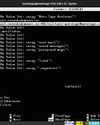Benchmark Linux
Linux Format
|June 2017
So, you think your system’s fast? Faster than Jonni Bidwell’s? Almost certainly. And now you can prove it with our awesome guide to speed testing.
-

The different hardware components in your computer all run at given speeds or have easily accessible speed limits. If your hard drive or SSD is attached to a SATA 3.0 bus then it has a theoretical maximum transfer rate of 600MB/s, while a fancy m.2 SSD (connected to a fast enough PCIe slot) will easily manage 2.5GB/s on a good day, and the bus itself (using 4 PCIe 3.0 lanes) can manage 3.9GB/s.
Yes, your CPU will change frequency according to load (likewise your GPU), and yes these things can be overclocked, but all these numbers can be looked up or otherwise calculated. The trouble is, most of the time they don’t correlate with real world performance, since most real world operations use a variety of different aspects of the system. For example, given all the specs of all the hardware involved, it’s still hard to say how quickly a system will boot a vanilla install of the latest Fedora. Likewise what kind of FPS you’ll see if you turn everything up to 11 on Shadow of Mordor. These real world measurements are tricky because they involve all kinds of intangibles – overheads introduced by the filesystem, code paths used by the graphics driver, latencies introduced by scheduling in the kernel. Tricky to predict, but, minus a few caveats, not so tricky to measure.
Benchmarking is the dark art of performing this measurement. It involves running standard programs that can be compared across different machines, each program testing some particular aspect of the system. But nothing’s ever simple and it’s easy to get benchmarking wrong. Background programs, thermal throttling, laptop power-saving and display compositors can all interfere. Games in particular tend to do better on one processor manufacturer or GPU driver. Using a particular title and assuming the results will give a objective ranking is foolhardy.
このストーリーは、Linux Format の June 2017 版からのものです。
Magzter GOLD を購読すると、厳選された何千ものプレミアム記事や、10,000 以上の雑誌や新聞にアクセスできます。
すでに購読者ですか? サインイン
Linux Format からのその他のストーリー

Linux Format
Create your first WebSocket service
Mihalis Tsoukalos explains how to use the Go programming language to work with the WebSocket protocol.
9 mins
April 2023

Linux Format
Fantastic Mr Firefox
Nick Peers takes a trip down memory lane to reveal the story behind the rise - and slight fall - of Mozilla's popular web browser.
9 mins
April 2023

Linux Format
Set up your terminal and email like it's 1983
Jump in the hot terminal time machine with Mats Tage Axelsson who emails from the command line using the latest technology.
8 mins
April 2023

Linux Format
Universal layer text effects with GIMP
Posters use them, films and presentations are hard to imagine without them: text effects. Attract attention with Karsten Günther and GIMP.
8 mins
April 2023

Linux Format
Jump to a federated social network
Nick Peers reveals how you can get up and running with this free, decentralised and non-profit alternative to Twitter.
9 mins
April 2023

Linux Format
Free our SOFTWARE!
Taking anything for granted is dangerous, so Jonni Bidwell and Mike Saunders revisit how the free software movement got started to help free us from proprietary tyranny!
4 mins
April 2023

Linux Format
Master RPI.GPIO
Les Pounder goes back to the early days of the Raspberry Pi - and his career with this classic library! -
5 mins
April 2023

Linux Format
Waveshare Zero to Pi3
Transform your Pi Zero into a Pi 3, they promised Les Pounder, but it's more like adding on go-faster stripes.
2 mins
April 2023

Linux Format
The Best OPEN SOURCE Software Ever!
In an attempt to trigger controversy, Michael Reed and Neil Mohr unequivocally state these are the greatest free software apps ever. Probably. We’re just trying to be helpful.
19 mins
April 2023

Linux Format
Linux-Mandrake 7
Simplicity and a wide range of applications make this a great distribution for all Linux users.
2 mins
April 2023
Translate
Change font size

